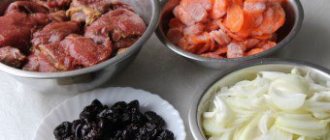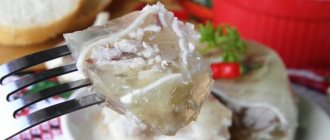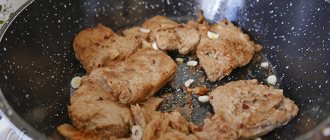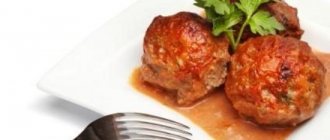Banosh recipe - banosh in a pot, recipe with photo / mag.relax.ua
Banosh is a traditional dish of the western region of Ukraine, which is very loved not only by its residents, but also by guests. In its composition, banosh is reminiscent of Hungarian hominy and Italian polenta, based on corn grits.
The Banosh recipe belongs to the Hutsul shepherds, who lived in the mountains for many months, grazing their flocks. For this dish they used sheep cheese, milk, and corn grits as the basis. Like gravy – mushroom sauce.
Sponder
In Lviv there is a store entirely dedicated to this wonderful product, although its prices are intended more for wealthy tourists than for local residents. Which, however, doesn’t stop you from going there, wandering between the counters, feeling the tempting smell tickling your nostrils and tasting a small piece of sponder for free. You can still find this product on the market, but sellers in the Carpathians are not as hospitable as at Odessa Privoz, and therefore will not treat you to sponder for free at every counter.
So what is it? When Galicians or any other residents of western Ukraine talk about shponder, they mean meaty pork undercut, baked in a wood-fired oven or in the oven.
On the map of cutting a pork carcass, the undercuts are located in the peritoneum, number 11 is indicated in the figure:
Figure – Pork carcass cutting map
It is known for certain that the first animal you come across is not suitable for preparing sponder. An ideal undercut suitable for the role of a sponder can only be obtained from a pig that has been fattened on a special diet. This diet allows the animal to form one to three thin layers of fat in the abdominal muscles, separated by layers of meat. Of course, it is not forbidden to use a fattier product, but its taste will deviate greatly from the “canon”.
Read more about how to choose the right pork.
Features of the veneer
The peculiarity of sponder is that it is dietary lard, no matter how paradoxical it may sound. Pork lard contains very healthy fatty acids that are easily digestible by the human body and do not lose their properties even after heat treatment. During long baking, most of the fat leaves the meat and evaporates, and the resulting product is a tasty and slightly dry dietary product.
Also, lard is low in carbohydrates and protein, which is also useful from a dietary point of view, since such a product, even when consumed frequently in small portions, does not allow you to gain weight, but at the same time saturates well due to its high calorie content.
Sponder recipe
In the debate over the correct recipe for making shponder, many forelocks have been torn out and a whole sea of vodka has been spilled. When the author of these lines had the imprudence to ask her neighbor about the recipe, she observed a desperate discussion that ensued between witnesses to the question and people passing by who stopped to say hello.
From all the diversity of opinions and further questioning, we were able to identify the two most common recipes:
• oven baking;
• roasting over a fire.
Let's look at each of these methods in detail.
Baking in the oven
To prepare this dish we need the following ingredients:
• pork chops 1 kg;
• several bulbs;
• 2-3 heads of garlic;
• hot mustard or its seeds, ketchup;
• black pepper and any aromatic seasonings for meat (except cloves).
Important note! The piece of undercut should be of medium thickness and long so that it can be easily rolled into a roll. At the first stage, this piece is generously smeared with garlic from a couple of heads crushed with a garlic press, after which it is set aside and the preparation of the sauce begins.
The sauce is the key component of the sponder, which gives it such a delicious taste and prevents it from drying out too much during baking. For the sauce, you need to add mustard or ketchup (it was they who became the subject of dispute between neighbors), a teaspoon of mustard seeds, spices and coarsely chopped onion (to taste). You can also add a teaspoon of table vinegar so that the marinade soaks the meat more thoroughly.
The resulting marinade is poured over a piece of lard, after which it is rolled into a roll, which is tied with thread. In this form, it should marinate in the refrigerator for at least 2-3 hours, and ideally for a day. The rope must be cotton, since synthetic material will release carcinogenic substances when exposed to temperature.
After marinating, the roll is carefully wrapped in foil and placed in an oven preheated to 180 degrees, where it is baked for 40-60 minutes. The finished product is removed from the oven, cooled and placed in the refrigerator for several hours. The resulting product is served cold.
Roasting over a fire
For roasting over a fire, the same ingredients are used as in the first recipe, with only one difference: there should be enough marinade to cover the product sealed in foil. To prepare sponder according to this recipe, fragrant firewood from coniferous trees is used, which is burned to the state of coals. A barbecue grate with a product on it is placed on a slight elevation from the coals.
It is impossible to say exactly how long the veneer will be baked: half an hour or 40 minutes, it all depends on the condition of the coals and the heat they give. Therefore, after half an hour, it is worth unfolding the foil and piercing the undercut, checking its appearance, the softness of the tissue, as well as the amount and condition of the marinade.
Sponder baked over a fire will turn out drier than baked in the oven (especially if you don’t add marinade), but it will delight the gourmet with the taste and smell of campfire smoke. This product is served both hot and chilled.
How to serve
The product is cut into thin slices and consumed as an independent snack. It is also used to make scrambled eggs (like bacon) or sandwiches. Sponder goes especially well as a snack with strong drinks: vodka, whiskey or strong Carpathian moonshine. Thanks to the meat, which is soaked in fat, intoxication occurs much more slowly, and the stomach is reliably protected from burns by alcohol.
Cold shponder is an excellent addition to the Carpathian dish called “banosh”, but that’s a completely different story.
What is banosh?
The recipes of our ancestors are sometimes unfairly forgotten by us, giving way to new fashionable dishes. But our grandmothers had simple, but incredibly tasty and healthy dishes in their arsenal. Tourists vacationing in the Carpathians have probably heard from the locals and even tried banosh in a cafe (the recipe is given in the article below).
The unusual name hides a traditional Transcarpathian dish made from corn grits. Real banosh is cooked over a fire, which is why it has a special aroma. It is served with cracklings, mushrooms and cheese. In the old days, such food was considered the lot of the poor, because they always had cornmeal and sour cream in stock, since each family had its own cow, and therefore dairy products.
Banosh, as part of the Hutsul soul
I first came across this dish in the small town of Turka, in Boykovshchina. Banosh attracted with an attractive photograph and a tasty description, but scared away with its price. When hunger finally drowned out the voice of reason and the cries of my thin wallet, it turned out that this dish was prepared only to order and was not available in the restaurant. Our second meeting with the banosh took place in Uzhgorod, and this time I was ready for it, both financially and culturally-historically.
Banosh, like feta cheese, was allowed to be cooked exclusively by men, because in the Carpathians it is believed that sheep-making and everything connected with it is a man’s business. Also, real rural Hutsuls speak disdainfully of the dish that is served in bars or restaurants or cooked on a home stove: they believe that a real banosh should be cooked over a fire so that “the smoke smells and the fire accumulates.”
Every self-respecting gadza (prosperous Hutsul landowner) should have a place in his yard to prepare banosh. What would it be like without him? After all, in Transcarpathia it is considered no less an everyday food than red borscht in the rest of Ukraine. There are strict canons for preparing this dish, for example, sour cream or cream for it must be three days old, and they must be stored strictly in the cellar so as not to sour. It is forbidden to put fresh sour cream for banosh in the refrigerator under pain of execution, because both the taste and beneficial properties will be “spoiled.” You only need to stir the milk product with a wooden spoon, since a metal spoon will not give the desired taste.
The origin of the dish is described as follows:
• In the Rakhiv region there is a belief that this dish was prepared when there was no food left in the house except sour cream and a handful of cornmeal. Why exactly banosh? Yes, because there was a gadza Banosh in Rakhiv, to whom, in response to dissatisfaction with hunger, the gadzinya said: “eat Banosh, eat Banosh.” This is where the name came from.
However, local historians and ethnologists have a slightly different opinion, believing that the dish came to us from the territory of modern Hungary. But the Hutsuls should not talk about this statement, since there is a risk of offending their feelings to the depths of their souls, of which Banosh is a part.
My ethnographic introduction has taken so long, it’s time to start writing the recipe!
Banosh recipe
For two good servings of banosh, which can quickly satisfy two very hungry people, we will need:
• 1.5 cups (200 grams) corn grits, very finely ground. Even corn flour will do, since it will require less sour cream and the banosh will cook faster.
• 500 grams of low-fat cream or liquid homemade sour cream. Those who do not like sour dishes should take this property of sour cream into account and add cream to their dish.
• Salt (to taste!).
• Shponder - Ukrainian smoked lard or bacon.
• BRYNZA!
If you bought and laid out the above products on the table in front of you, then don’t hesitate and start cooking:
• Sour cream or cream should be poured into a cast iron cauldron or duck pot and brought to a boil. If necessary, dilute with water.
• Pour corn porridge or flour into boiling sour cream in a thin stream (so that it does not clump) and stir with a spoon. Be sure to monitor the thickness of the dish, which should be the consistency of semolina porridge, but not thicker!
• When the porridge is poured in and stirred, it’s time for sponder or bacon, which is cut into thin strips or slices and fried in a frying pan until cracklings are formed. When we repeated the restaurant recipe at home, we also had sheep sausage with us, which we took from some Romanians in Uzhgorod. We fried her too.
• Reduce heat to low and stir the cooking porridge with a wooden spoon until droplets of oil appear on the surface. As soon as they shine, you need to immediately remove the dish from the heat. This step is extremely important because the banosh needs to be thoroughly beaten so that the cream or sour cream turns into melted butter.
• The banosh prepared in this way is poured into deep plates, putting cracklings on top and whittling out a good piece of cheese. Lightly salted cucumbers also go very well with the dish.
The finished product must be consumed hot and always very hungry! After the third spoon, you will feel tired and satisfied with the life of Gadza, who has lunch at home after a working day.
Banosh in Transcarpathian style: ingredients
It has long been believed that only men should cook banosh. And the taste of this dish is truly masculine - juicy, rich! But times have changed, women can cook it too, and the resulting banosh is no less tasty. A little secret that will really change the taste of the finished dish is to use exclusively homemade products.
Can you find homemade sour cream and milk or replace them with store-bought ones, but here’s what you need to make banosh, the recipe for which you will now learn with a photo:
- Milk - 400 ml (choose the highest fat content).
Sour cream - 500 ml.
Very finely ground corn grits - 200 g.
Cheese cheese - 100 g.
Salt to taste.
Stock up on the necessary products and read about how to prepare banosh at home so that it turns out no less tasty than that of the indigenous inhabitants of Eastern Europe.
It is best to cook banosh over a fire, but if you are limited by your kitchen, then prepare a cauldron - it will give you the opportunity to change the taste of the finished dish.
Banosh with cheese
Banosh with feta cheese has an original taste. To prepare it you need to take:
- Cream or homemade sour cream - 0.4 l.
- Glass of water.
- Corn flour or grits - 0.2 kg.
- Brynza - 0.2 kg.
- Butter - 40 g.
- Salt.
We put the pan on the fire, pour in water and let it boil, after which we immediately add corn flour and add salt. Cook the porridge, remembering to stir constantly. When the banosh is almost ready, add sour cream and continue stirring. Add oil to the prepared porridge and let it brew. Meanwhile, we grind the cheese. Serve the dish hot, sprinkling cheese on top. The consistency of banosh can be very thick or more liquid, it depends on the amount of water you pour during cooking.
Benefits of banosh
The main component of the dish is corn grits, which are rich in fiber. It perfectly cleanses the intestines, while preventing the development of putrefactive processes in the body. The selenium it contains protects against stress and slows down aging. Porridge is recommended for children and elderly people, as it contains a large amount of carotene and strengthens the immune system. It also does not cause allergies.
Banosh, the recipe for which is described above, is useful for people suffering from anemia. It contains vitamins E and B12. Pregnant women, who often suffer from a lack of folic acid, simply cannot do without porridge on the menu. It should be the basis of their diet. Banosh also contains magnesium, potassium and phosphorus - microelements that contribute to the normal functioning of the cardiovascular system.
But it is worth noting that with all the advantages of the dish, it also has a number of contraindications. Thus, banosh is very high in calories, so it is not recommended for people prone to obesity and those with high blood cholesterol levels. It is also prohibited for patients with problems with the gastrointestinal tract.
Hutsul banosh is an everyday dish that is prepared in the Carpathians, namely in the mountainous regions. About three or even four times a week it appears on the dinner table of local residents. Previously, banosh was considered the food of the poor, but nowadays it is a national and extremely popular dish. It is served in local cafes and restaurants. The local population claims that Hutsul banosh cannot be cooked at home, as it is made in a large cauldron over a fire. It is with the help of this heat treatment that the dish acquires a magnificent taste and divine aroma.
If it is not possible to cook over a fire, Hutsul banosh is cooked at home. A step-by-step banosh recipe will help you cope with the task and prepare the national Ukrainian dish. As for the banosh ingredients, the recipe suggests using not only cornmeal, but also sheep/goat cheese. In addition, you cannot do without fried lard, namely cracklings. It is advisable to use a good piece of lard that has a meaty cut. Some people add porcini mushrooms to make the taste and aroma of banosh more rich, vibrant and memorable.
To make the banosh real, it is important to follow some rules. First of all, such a Hutsul dish should be prepared by a man. The ideal way to cook is in a cauldron over a fire, as the dish should absorb the wonderful smell of smoke and absorb the strength and energy from the fire.
The second, no less important rule is that the dish is prepared with homemade sour cream, which has been left in the refrigerator for three days. The main highlight of banosh is that it should have a light, unobtrusive sourness.
Do not use cream instead of sour cream, it will give a different taste. If you wish, you can dilute the full-fat sour cream using water or milk.
The third rule is hidden in the magic of the Hutsul dish. That is why, according to ancient legend, the dish should be stirred in one direction using a wooden spoon. If you use an ordinary iron spoon, you will not be able to achieve the desired taste. As for readiness, the dish itself will tell you when to remove the dish from the heat. Banosh is stirred until oil droplets begin to appear on the walls of the pan. At this stage, the liquid, sticky porridge becomes slippery, tender, and smooth. This indicates that the banosh is dancing.
What products are used to prepare the dish?
They say that the most delicious banosh (the recipe is given in the article) can only be tasted in the Carpathians. Here it is prepared with homemade sour cream from sheep's milk and cheese. Moreover, they do not use fresh fermented milk product, but three-day-old sour cream from the cellar.
If anyone is interested in trying this dish, then you can cook it yourself. Of course, you will have to slightly modify the recipe for banosh with sour cream, since in urban conditions it is unlikely that you will be able to find fermented milk products made from sheep’s milk. To prepare, you can use homemade cow cheese and sour cream. If you can’t find homemade fermented milk products, you can buy heavy cream at the store. It is better not to use factory-made sour cream, as it has an acidity that can spoil the taste of food.
In addition, during cooking it is necessary to use a wooden spoon, but it is better not to use a metal one (metal gives a sour taste). If you want to get a real banosh (the recipe is given in the article), then it is better to stock up on fine corn grits or flour. An ordinary saucepan is not suitable for preparing such a dish. The most delicious porridge is made in clay pots and cast iron pots.
Banosh with mushrooms
Banosh can also be prepared with mushrooms. To do this, bring the sour cream to a boil and add corn flour, adding salt and sugar. During cooking, you need to constantly stir the porridge until it thickens. Next, reduce the heat and persistently rub the banosh until oily spots appear on the surface. Experts say that the main secret of preparing such porridge is that it needs to be stirred with a wooden spoon in only one direction.
A ready-made, properly cooked banosh should have the consistency of semolina porridge and at the same time easily pull away from the walls of the dish.
All kinds of additives for the dish are prepared separately. Mushrooms can be used as an additional component that significantly diversifies the taste of the porridge. They are soaked and fried in the lard that remains after cooking the greaves. In addition, you can add grated cheese, which melts in the hot porridge and gives a wonderful taste.
The finished dish is served hot, layered with ingredients: banosh, feta cheese, cracklings and mushrooms. The porridge is eaten without stirring. You can decorate it with fresh herbs on top.










